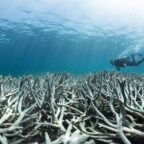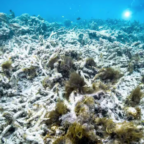
Scientists have conducted the longest coral reef survey to date at Australia’s iconic Great Barrier Reef, confirming fears that large parts of this natural wonder are too damaged to recover within the foreseeable future. In the journal Nature Communications, researchers at Bar-Ilan University in Israel and the University of Queensland in Australia provide an in-depth look at Australia’s Great Barrier Reef over the past 91 years.
The work used data from an aerial photography survey carried out in 1928 by the Great Barrier Reef Committee and the Royal Society of London and compared the findings from expeditions taken in 2004, 2015, and 2019.
Their work suggests that parts of the coral reef have been subjected to major environmental change, on both a local and global level, over the past century. All of this has taken a toll, amounting to a considerable decline in coral cover and reduced diversity of both corals and invertebrates.
For example, the study notes that “species richness was 50 percent lower in 2004 and 2015 when compared to 1950 and 1928.” In 2019, that figure dropped to 37 percent of the species richness in 1928.
One of the prime factors threatening the health of coral reefs is climate change. Increased carbon dioxide levels in the atmosphere result in the oceans uptaking more carbon dioxide, which makes the water more acidic.
As the sea temperature anomalies become more frequent and sea acidity gently rises, coral reefs are more likely to experience mass coral bleaching. This occurs when conditions become too harsh for the symbiotic algae (or zooxanthellae) that co-exist with the coral polyps and they “abandon ship”. Since these microorganisms are often what give the coral its coloring, the reefs appear pale and washed out. Although coral reefs can recover from the odd season of mild bleaching, parts of the Great Barrier Reef are leaving few signs they will return to their initial state in the near future.
Cyclones can also play an influential role in the health of coral reefs, especially shallow reefs. Nevertheless, the research notes that when a cyclone hit the reef in 1950, it appeared to have a mild effect on coral cover and diversity when it was documented in 1954. If this is compared to more recent cyclones, it suggests that part of the reef has become less resilient to disturbances. While the explanation is likely complex and multi-faceted, these observations indicate the Great Barrier Reef is starting to show the scars from “multiple cumulative stresses and unparalleled change over long periods of time.”
“The degree to which reefs may shift from one state to another following environment change was overwhelming,” lead author Professor Maoz Fine, of the Mina and Everard Goodman Faculty of Life Sciences at Bar-Ilan University, said in a statement. “The long-term implications of these changes highlight the importance of avoiding phase shifts in coral reefs which may take many decades to repair, if at all.”














Social Profiles